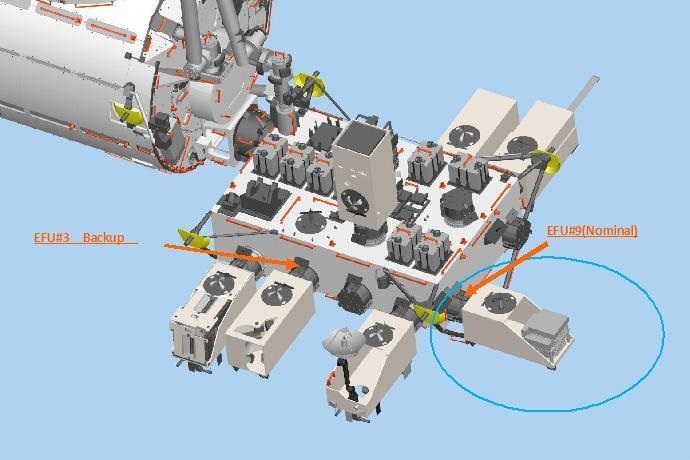CALET – Calorimetric Electron Telescope
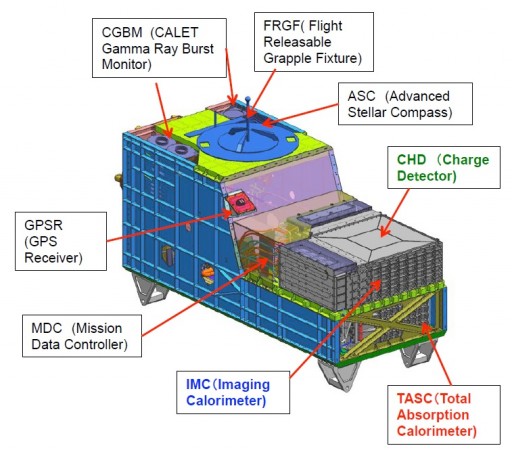
CALET, the Calorimetric Electron Telescope, sets out to address a number of open questions of High-Energy Astrophysics such as the origin of cosmic rays, the mechanisms behind the acceleration of cosmic rays and galactic propagation, the existence of dark matter and its structure, and nearby sources of cosmic rays. The search for signatures of dark matter has become a focus of particle astrophysics since dark matter is hypothesized to be one of the major constituents of the universe.
CALET is capable of making direct measurements at the highest energy levels in the cosmic ray electron spectrum for the observation of discrete sources of high energy particle acceleration in our local region within the Milky Way. The telescope payload has a mass of 650 Kilograms and looks forward to a two to five-year stay attached to the Japanese Experiment Module Exposed Facility, Port #9, looking zenith.
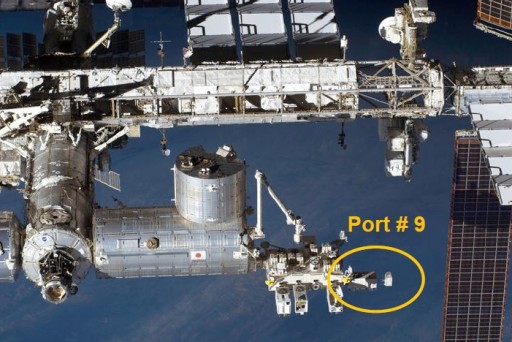
CALET consists of a detector system and data processing units, support sensors and an interface unit that attaches the payload to the Exposed Facility. The detector system is comprised of a Charge Detector, an Imaging Calorimeter, a Total Absorption Calorimeter and the CALET Gamma Ray Burst Monitor. The support sensors include a GPS receiver and an Advanced Stellar Compass for precise position and orientation determination.
The CALET instrument interfaces with the JEM Exposed Facility via a standard Flight Releasable Attachment Mechanism which includes power and data interfaces with the Station’s systems. CALET requires a peak power of 650 Watts and operates at data rates of 35kbps in low data mode and 600kbps in high data mode. The payload measures 1.85 by 0.8 by 1.0 meters in size, complying with the envelope available for external JEF payloads.
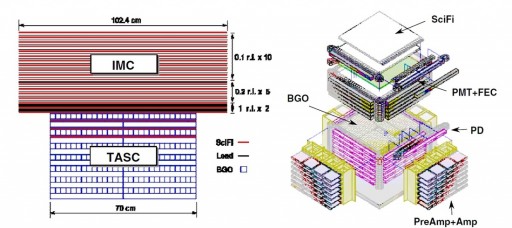
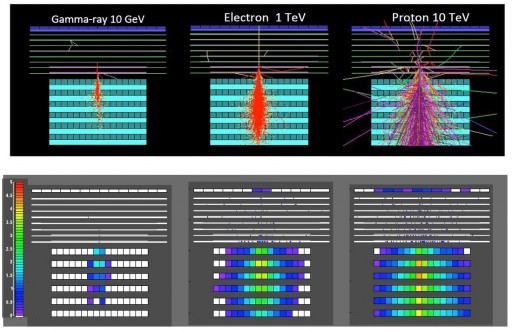
The three main sensor elements of CALET are the Charge Detector, the Imaging Calorimeter and the Total Absorption Calorimeter. The Charge Detector consists of two layers each consisting of 14 organic scintillator paddles provided by ELJEN Technology. Each of the paddles measures 45 centimeters by 3.2 by 1 cm with the different layers arranged orthogonally. The organic scintillator material absorbs the energy of incident ionizing radiation and re-emits the absorbed energy in the form of light that can be measured in a detector. CALET uses Photomultiplier Tubes with eight-millimeter photocathodes to detect the emission of radiation from each scintillator paddle. Through data processing, the charge of each incident particle can be measured in a range from Z=1 to Z=40.
Imaging Calorimeters are characterized by a finely granulated readout with a high degree of segmentation featuring a large number of readout channels as opposed to conventional calorimeters consisting of large crystals connected to a single read-out channel. This allows for a detailed measurement of particle identity, travel direction and energy as well as the creation of Particle Flow Algorithms. Imaging Calorimeters have a sandwiched design, alternating between active detector elements and passive absorber elements.
The CALET Imaging Calorimeter makes use of seven Tungsten plates as absorbers and 16 layers of 448 Scintillating Fibers, one stack of eight layers in the x-plane, the other in the y-plane to enable directional measurements.
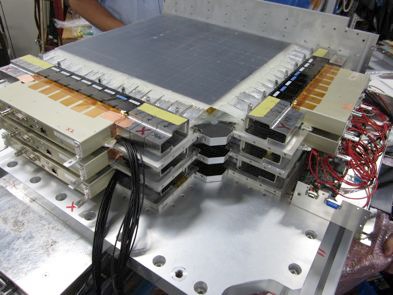
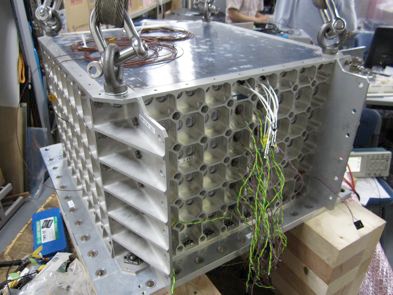
Each of the fibers measures 44.8 by 0.1 by 0.1 centimeters. Emissions from the fibers are read out by a suite of Multi-Anode (64) Photomultipliers coupled to Readout Electronics based on application-specific integrated circuits that digitize the signals from each fiber with precise time-stamps for event logging. The arrangement of active elements within the system has been chosen to provide the precision necessary to separate incident particles from backscattered particles, precisely determine the starting point of the shower and determine the incident particle trajectory. The primary purpose of the CALET Imaging Calorimeter is the measurement of particle direction while the energy measurement is accomplished with the Total Absorption Calorimeter.
Located atop the Imaging Calorimeter is a silicon detector array consisting of two layers with 6,400 pixels, each square in shape with a side length of 1.125 centimeters and a thickness of 500 microns. The Silicon Detector Array delivers the necessary charge resolution for the measurement of light and heavy nuclei.
The Total Absorption Calorimeter consists of 12 layers each comprised of 16 Lead-Tungstate logs that act as absorbing material, each measuring 32.6 by 1.9 by 2.0 centimeters in size. Subsequent layers are arranged orthogonally. Events are triggered by a Photomultiplier Tube that is located atop the uppermost layer to send a start pulse. The remaining layers feature avalanche photodiodes for the measurement of the depth of penetration of any given particle to assess its energy. The Total Absorption Calorimeter has a field of view of 45 degrees around the zenith. It separates electrons and gamma rays from incident hadrons.
A separate Gamma-Ray Burst Monitor can detect particle events from a few keV X-Rays to gamma-rays in the TeV range with durations varying from short duration gamma ray bursts, x-ray flashes to longer burst events. It has a time resolution of 62.5 microseconds and an energy range of 3% at 10 GeV. Two components make up the Gamma Ray Burst Monitor, the Soft Gamma-Ray Monitor SGM and the Hard X-Ray Monitor HXM. SGM uses a single Bismuth Germanate scintillator 102 by 76 millimeters in size covering an energy range of 100 to 20,000 keV. The HXM features a dual detector element using Lanthanum Bromide scintillators 12.7 millimeters thick and 66 by 79 centimeters in diameter. It covers an energy range of 7 to 1,000 keV. A Beryllium entrance window is used for the measurement of soft X-Rays below 10 keV.
Gamma Ray Burst Monitor Components

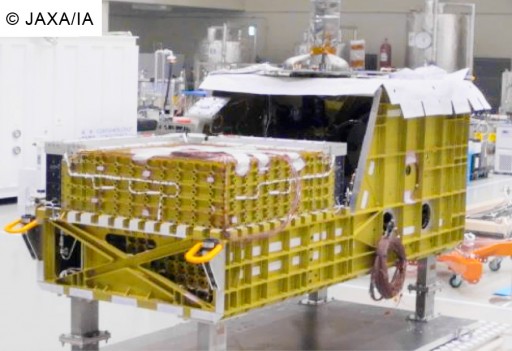
The non-detecting area of the entire CALET detector system is surrounded by a segmented scintillator array to serve as an Anti-Coincidence Detector, being triggered by all particles arriving from a direction that does not strike a detector from above, instructing the instrument to reject that measurement.
The thickness of the calorimeter sensors allows measurements well into the Terra-Electron-Volt (TeV) energy region with excellent energy resolution. The coupling of an imaging and total absorption calorimeter permits an accurate identification of the starting point of electromagnetic showers as well as the lateral and longitudinal development of showers.
CALET will deliver electron spectra in the trans-TeV region to look for nearby cosmic-ray sources, it will track dark matter annihilation electron/positron signatures in electron/gamma energy spectra at energies of 10 GeV to 10 TeV, it will provide spectral data sets starting with protons to heavier elements up to iron at 20TeV/n plus heavier elements (Z=26-40) at a few GeV/n.
CALET will also measure the electron flux at energies below 10 GeV to support solar physics and record Gamma-ray and X-Ray events in the low-energy range from 3keV to 30 MeV. Gamma-ray measurements for an indirect measurement of dark matter decay will also be supported by CALET.
CALET delivers its data flow to the ISS Data System where science data is stored or downlinked in real time depending on TDRSS availability. Downlinked data is relayed to the Marshall Spaceflight Center from where raw data is transmitted to Tsukuba Space Center, going through the JAXA Operations Control System to reach the CALET Ground System. Raw data is directed to an archiving system and to the various processing locations where higher science products from Level 1 quick look data to Level 3 calibrated calorimeter and Gamma-Ray Burst Monitor Data is created, archived and made available via a web server.
